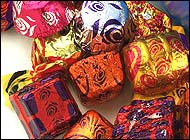Semi Rigid Packaging
The
use of semi rigid packaging materials began with the Chinese, They used
sheets of treated mulberry bark to wrap foods as early as the first or
second century B.C. During the following centuries, the Chinese also
developed and refined the techniques of paper making. Knowledge of how to
make paper gradually moved west across Asia and into Europe. In 1310, paper
making was introduced to England. The technique arrived in America in
Germantown, Pennsylvania, in 1690.
Paper is basically a thin sheet of cellulose. Cellulose is a fibrous
material derived from plants. Early paper was made from cellulose fibers
derived from flax, the plant that also gives fibers for linen cloth. As
demand for paper grew, old linen rags were sought as a source of fiber.
In 1867, the process for deriving useful cellulose fiber from wood pulp was
developed. Because wood was so cheap and plentiful, this fiber source
rapidly replaced cloth fibers as the primary source of paper fiber. Today,
virtually all paper has wood pulp as the source of cellulose fiber.
An important step for the use of paper in packaging came with the
development of paper bags. Commercial paper bags were first manufactured in
Bristol, England, in 1844. Shortly thereafter, in 1852, Francis Wolle
invented the bag-making machine in the United States. Further advancements
during the 1870s included glued paper sacks and the gusset design, producing
the types of paper bags used today. In 1905, machinery was invented to
automatically produce in-line printed paper bags.
With the development of the glued paper sack, the more expensive cotton
flour sacks could be replaced. But a sturdier multiwalled paper sack for
larger quantities did not replace cloth until 1925, when a means of sewing
the ends was finally invented.
Another important use of paper in packaging came with the development of
paperboard -- the kind of paper that packages a box of cereal. The first
paperboard carton -- often called a cardboard box -- was produced in England
in 1817, more than two hundred years after the Chinese invented cardboard or
paperboard.
Another common form of "cardboard" based on corrugated paper
appeared in the 1850s. Basically, this form of cardboard is made from thin
sheets of paperboard that are molded into a wavy shape and then "faced"
or sandwiched between two flat sheets of paperboard. The strength,
lightness, and cheapness of this material make it very useful for shipping
and storing. However, replacing wooden crates with the new paper alternative
would prove to be something of a battle. Nevertheless, about 1910, after
much litigation between manufacturers and the railroads, shipping cartons of
faced corrugated paperboard began to replace self-made wooden crates and
boxes used for trade. Today, cardboard boxes -- more accurately called "C-flute
corrugated paperboard cartons" -- are used almost universally for
product shipping.

As with many innovations, the development of the carton was accidental.
Robert Gair was a Brooklyn printer and paper-bag maker during the 1870s.
While he was printing an order of seed bags, a metal rule normally used to
crease bags shifted in position and cut the bag. Gair concluded that cutting
and creasing paperboard in one operation would have advantages; the first
automatically made carton, now referred to as "semi-flexible packaging,"
was created. Such folding cartons or "tubular cartons" dominate
the dried, processed food market.
The development of flaked cereals advanced the use of paperboard cartons.
The Kellogg brothers were first to use cereal cartons. The Kelloggs operated
a sanatorium at Battle Creek, Michigan. They developed flaked cereals as a
health food for their patients, but soon began marketing this new food
product on a mass scale. Their original packaging was a waxed, heat-sealed
bag of Waxtite wrapped around the outside of a plain box. The outer wrapper
was printed with the brand name and advertising copy. Today, of course, a
plastic liner protects cereals and other products within the printed carton.
Some cereal manufacturers have attempted to sell cereal in flexible pouches,
like snack foods. However, U.S. consumers have only marginally accepted
cereals in a pouch only, so we continue to see a bag-in-box format for
cereals.
Paper and paperboard packaging increased in popularity throughout much of
the 20th century. Then with the advent of plastics as a significant player
in packaging (late 1970s and early 1980s), paper and its related products
were replaced in many uses. Lately that trend has slowed as designers have
tried to respond to the perception that plastic is environmentally
unfriendly. The fact is that decreasing that amount of material in packaging
is usually more important than the composition of the package to get the
most environmentally friendly form of packaging.


 As with many innovations, the development of the carton was accidental.
Robert Gair was a Brooklyn printer and paper-bag maker during the 1870s.
While he was printing an order of seed bags, a metal rule normally used to
crease bags shifted in position and cut the bag. Gair concluded that cutting
and creasing paperboard in one operation would have advantages; the first
automatically made carton, now referred to as "semi-flexible packaging,"
was created. Such folding cartons or "tubular cartons" dominate
the dried, processed food market.
As with many innovations, the development of the carton was accidental.
Robert Gair was a Brooklyn printer and paper-bag maker during the 1870s.
While he was printing an order of seed bags, a metal rule normally used to
crease bags shifted in position and cut the bag. Gair concluded that cutting
and creasing paperboard in one operation would have advantages; the first
automatically made carton, now referred to as "semi-flexible packaging,"
was created. Such folding cartons or "tubular cartons" dominate
the dried, processed food market.